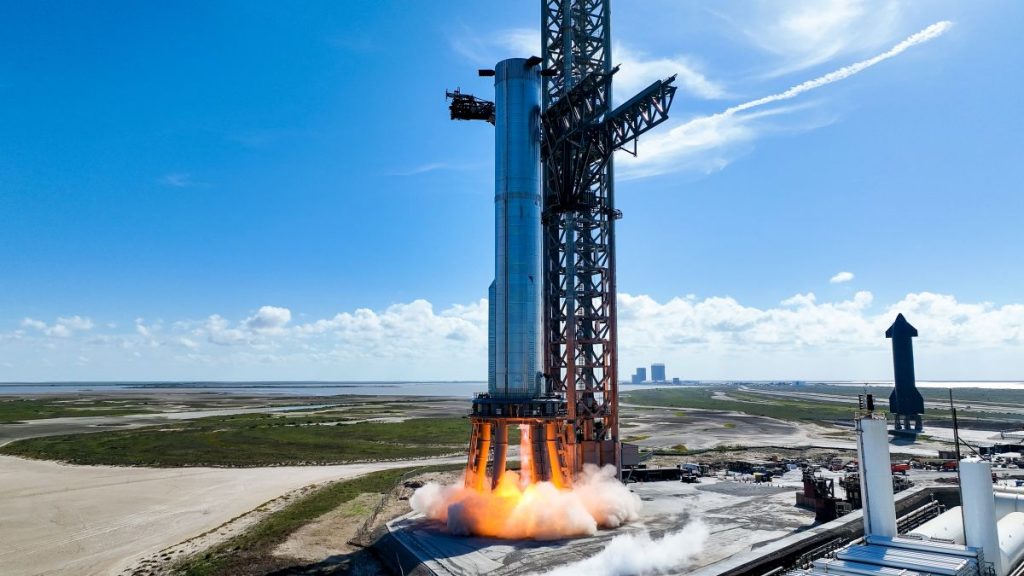SpaceX fired up a Super Heavy booster on the launch pad today (Aug. 9) for the first time ever, notching a big milestone in the development of its Starship deep-space transportation system.
The Super Heavy in question, a prototype known as Booster 7, is scheduled to launch on the Starship program’s first orbital test flight in the coming months. SpaceX is gearing up for that mission, as today’s engine test shows.
The test, which took place this afternoon at SpaceX’s Starbase facility in South Texas, involved just one of Super Heavy’s 33 Raptor engines, company representatives said via Twitter (opens in new tab). The engine lit up while Booster 7 remained anchored to the orbital launch mount, in a test known as a static fire.
Photos: SpaceX lifts huge Super Heavy rocket onto launch stand
The Starship system consists of Super Heavy and a 165-foot-tall (50 meters) upper-stage spacecraft called Starship. Both elements are designed to be fully reusable, and both will be powered by the next-generation Raptor, which is much more powerful than the Merlin engine that SpaceX uses with its Falcon 9 and Falcon Heavy rockets.
Starship upper-stage prototypes have launched before, on test flights that reached a maximum altitude of just 6.2 miles (10 kilometers) or so. Those jaunts involved vehicles with three engines, half of what the final Starship spacecraft will sport.
No Super Heavy vehicle has yet left the ground, though the upcoming orbital test flight will change that, if all goes according to plan. On that mission, which will lift off from Starbase, Booster 7 will launch a six-engine Starship prototype called Ship 24 to orbit. Booster 7 will splash down in the Gulf of Mexico shortly after liftoff, and Ship 24 will circle Earth once before coming down in the Pacific Ocean near the Hawaiian island of Kauai.
And Ship 24 got a workout today, too: A few hours after the Booster 7 activity, SpaceX conducted a static fire with two of Ship 24’s six Raptors, the company announced via Twitter (opens in new tab).
Static fire test of two Raptor engines on Starship 24 pic.twitter.com/NNpViztphIAugust 10, 2022
SpaceX likely will perform a lot more testing before clearing Booster 7 and Ship 24 for that landmark launch. But some of those prelaunch trials will be big events in themselves. The first time that Booster 7 fires up all 33 of its Raptors, for example, will be a sight — and a sound — to behold. (For perspective: The Falcon 9 has just nine engines in its first stage, as the rocket’s name suggests.)
Though today marked Booster 7’s first static fire on the launch mount, it has breathed fire at Starbase before. On July 11, flames shot from the vehicle’s base after something went wrong during an “engine spin start test.”
Tuesday was a very busy day for SpaceX. On Tuesday night, the company launched 52 of its Starlink internet satellites to orbit with a Falcon 9, which lifted off from NASA’s Kennedy Space Center in Florida. The rocket’s first stage came down for a vertical landing at sea on one of SpaceX’s autonomous drone ships a little less than nine minutes after launch.
Editor’s note: This story was updated at 10:12 p.m. EDT on Aug. 9 with news of Ship 24’s static fire, then again at 10:57 p.m. EDT with details and video from SpaceX and news of the Starlink launch.
Mike Wall is the author of “Out There (opens in new tab)” (Grand Central Publishing, 2018; illustrated by Karl Tate), a book about the search for alien life. Follow him on Twitter @michaeldwall (opens in new tab). Follow us on Twitter @Spacedotcom (opens in new tab) or on Facebook (opens in new tab).

